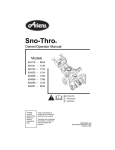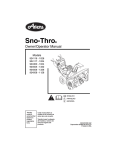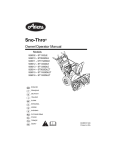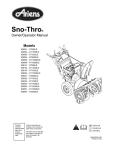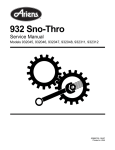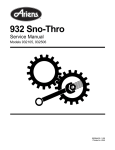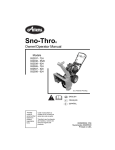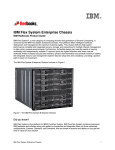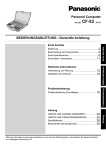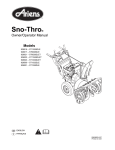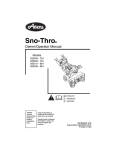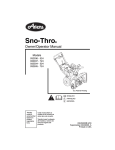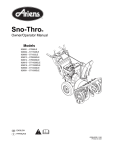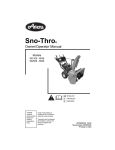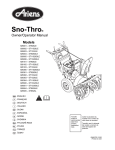Download Ariens 924 SNO-THRO 924112 Service manual
Transcript
924 Snow-Thro Service Manual Models 924124-128, 924335-338, 924516, 924517 00040600A 1/05 Printed in USA TABLE OF CONTENTS Section 1 - Introduction . . . . . . . . . . . . . . . . . 1.1 The Manual . . . . . . . . . . . . . . . . . . . . . . . 1.2 Service and Replacement Parts . . . . . . . 1.3 Product Registration . . . . . . . . . . . . . . . . 1.4 Unauthorized Replacement Parts . . . . . . 1.5 Disclaimer . . . . . . . . . . . . . . . . . . . . . . . . 1.6 Technical Service Communications . . . . . 1.5 1.5 1.5 1.5 1.5 1.5 1.5 Section 2 - Safety . . . . . . . . . . . . . . . . . . . . . . 2.1 Safety Alerts . . . . . . . . . . . . . . . . . . . . . . 2.2 Signal Words . . . . . . . . . . . . . . . . . . . . . . 2.3 Notations . . . . . . . . . . . . . . . . . . . . . . . . . 2.4 Practices and Laws . . . . . . . . . . . . . . . . . 2.5 Required Operator Training . . . . . . . . . . . 2.6 Preparation . . . . . . . . . . . . . . . . . . . . . . . 2.7 Service Position . . . . . . . . . . . . . . . . . . . . 2.8 Cleaning and Storage . . . . . . . . . . . . . . . 2.9 Safety Rules . . . . . . . . . . . . . . . . . . . . . . 2.6 2.6 2.6 2.6 2.6 2.6 2.6 2.7 2.7 2.7 Section 5 - Handlebars & Controls . . . . . . . .5.23 5.1 Handle Bars . . . . . . . . . . . . . . . . . . . . . . .5.23 5.2 Controls . . . . . . . . . . . . . . . . . . . . . . . . . .5.23 5.3 Clutch Yoke And Fork . . . . . . . . . . . . . . .5.24 Section 6 - Engine . . . . . . . . . . 6.1 Engine Troubleshooting . . 6.2 Removing the Engine. . . . 6.3 Installing The Engine . . . . ...... ...... ...... ...... . . . . . .6.25 . . . . . .6.25 . . . . . .6.26 . . . . . .6.26 Section 7 - Reduction Drive . . . . . . . . . . . . . .7.27 7.1 Differential, Lockout, And Axle . . . . . . . . .7.27 7.2 Axle Bearings. . . . . . . . . . . . . . . . . . . . . .7.28 7.3 Pinion, Shaft, And Sprocket . . . . . . . . . . .7.28 7.4 Idler Shaft. . . . . . . . . . . . . . . . . . . . . . . . .7.28 7.5 Drive Chain . . . . . . . . . . . . . . . . . . . . . . .7.28 Section 8 - Friction Wheel Drive . . . . . . . . . .8.29 8.1 Friction Disk . . . . . . . . . . . . . . . . . . . . . . .8.29 8.2 Friction Wheel Housing . . . . . . . . . . . . . .8.29 8.3 Drive Plate Spindle. . . . . . . . . . . . . . . . . .8.29 Section 3 - Specifications . . . . . . . . . . . . . . . 3.10 Section 4 - General Maintenance & Section 9 - Auger/Impeller . . . . . . . . . . . . . . .9.31 9.1 Auger/Impeller Removal . . . . . . . . . . . . .9.31 9.2 Scraper Blade . . . . . . . . . . . . . . . . . . . . .9.31 9.3 Shear Bolts . . . . . . . . . . . . . . . . . . . . . . .9.31 9.4 Discharge Chute . . . . . . . . . . . . . . . . . . .9.32 9.5 Deflector. . . . . . . . . . . . . . . . . . . . . . . . . .9.34 9.6 Runners . . . . . . . . . . . . . . . . . . . . . . . . . .9.34 Adjustments . . . . . . . . . . . . . . . . . . . . . . . .4.12 4.1 Controls and Features . . . . . . . . . . . . . . . 4.12 4.2 Service Positions . . . . . . . . . . . . . . . . . . . 4.13 4.3 Filling The Fuel Tank . . . . . . . . . . . . . . . . 4.14 4.4 Pre-Start. . . . . . . . . . . . . . . . . . . . . . . . . . 4.14 4.5 Maintenance Schedule . . . . . . . . . . . . . .4.15 4.6 Storage . . . . . . . . . . . . . . . . . . . . . . . . . . 4.15 4.7 General Lubrication . . . . . . . . . . . . . . . . . 4.15 4.8 Auger Gearcase. . . . . . . . . . . . . . . . . . . . 4.16 4.9 Engine . . . . . . . . . . . . . . . . . . . . . . . . . . .4.16 4.10 Traction Drive Belt replacement. . . . . . . 4.17 4.11 Attachment Drive Belt replacement . . . . 4.17 4.12 Shear Bolts . . . . . . . . . . . . . . . . . . . . . . 4.19 4.13 Tire Pressure . . . . . . . . . . . . . . . . . . . . . 4.19 4.14 Battery . . . . . . . . . . . . . . . . . . . . . . . . . . 4.19 4.15 Adjustments . . . . . . . . . . . . . . . . . . . . . . 4.20 Section 10 - Gear Case . . . . . . . . . . . . . . . . . 10.35 10.1 Cast Iron Gear Case (Worm Gear) . . . 10.35 10.2 Aluminum Gear Case. . . . . . . . . . . . . . 10.35 Section 11 - Electrical 11.1 Continuity Diagram. . . . . . . . . . . . . . . . 11.38 11.2 Wiring Diagrams. . . . . . . . . . . . . . . . . . 11.39 Section 12 - Troubleshooting. . . . . . . . . . . . 12.42 2 Ariens Company 655 West Ryan Street P.O. Box 157 Brillion, Wisconsin 54110-0157 USA Telephone (920) 756-2141 Facsimile (920) 756-2407 EC DECLARATION OF CONFORMITY ISSUED BY THE MANUFACTURER DÉCLARATION DE CONFORMITÉ CE ÉMISE PAR LE FABRICANT – EU-ÜBEREINSTIMMUNGSERKLÄRUNG DES HERSTELLERS – DICHIARAZIONE DI CONFORMITÀ CE RILASCIATA DAL PRODUTTORE – DECLARACIÓN DE CONFORMIDAD CE EMITIDA POR EL FABRICANTE – EF-SAMSVARSERKLÆRING FRA PRODUSENTEN – EG-DEKLARATIONEN OM ÖVERENSSTÄMMELSE UTFÄRDAD AV TILLVERKAREN – VALMISTAJAN ANTAMA EY-VAATIMUSTENMUKAISUUSVAKUUTUS – DEKLARACJA ZGODNOŚCI Z PRZEPISAMI EC WYDANA PRZEZ PRODUCENTA – We the undersigned, ARIENS COMPANY, certify that: Nous, soussignés ARIENS COMPANY, certifions que : Der Unterzeichnete, ARIENS COMPANY, bescheinigt, dass: La sottoscritta società ARIENS COMPANY certifica che: Nosotros, los abajo firmantes, ARIENS COMPANY, certificamos que: Undertegnede, ARIENS COMPANY, bekrefter at: Undertecknad, ARIENS COMPANY, intygar att: Allekirjoittanut, ARIENS COMPANY, vakuuttaa, että: My, niźej podpisani, ARIENS COMPANY, oświadczamy, że: Type: Type : Typ: Tipo: Tipo: Type: Typ: Tyyppi: Typ: WALK BEHIND SNOW THROWER – LES CHASSES-NEIGE AUTOTRACTÉS – HANDGEFÜHRTE SCHNEEFRÄSE – SPAZZANEVE SEMOVENTE – CAMINAR POR DETRÁS DE LA LANZADORA DE NIEVE – SNØFRESER – SJÄLVGÅENDE SNÖSLUNGA – KÄSINOHJAILTAVA LUMILINKO – ODGARNIACZ ŚNIEGU DO PROWADZENIA PRZED SOBĄ Trade Name: Appellation commerciale : Handelsbezeichnung: Nome commerciale: Nombre comercial: Handelsnavn: Handelsbeteckning: Kauppanimi: Nazwa handlowa: Model: Modèle : Modell: Modello: Modelo: Modell: Modell: Malli: Model: Ariens 924335, 924336, 924337, 924338, 924516, 924517 Conforms to: Est conforme à : Mit den Anforderungen der folgenden Richtlinien übereinstimmt: È conforme a: Cumple con: Er i samsvar med: Överensstämmer med: Täyttää seuraavat vaatimukset: Jest zgodny z: 98/37/EC, 89/336/EEC, 2000/14/EC Conformity Assessment Annex V. Annexe V de l'évaluation de conformité. Konformitätsbewertung, Anhang V. Annesso V della valutazione di conformità. Anexo V de la evaluación de la conformidad. Samsvarsvurdering etter vedlegg V. Bedömning av överensstämmelse Bilaga V. Vaatimustenmukaisuuden arviointi, liite V. Dodatek V, Ocena zgodności. 3 Representative Measured Sound Power Level (Lwa) – Niveau de puissance acoustique représentatif mesuré (Lwa) – Repräsentativer gemessener Geräuschpegel (Lwa) – Livello di potenza sonora rappresentativo rilevato (Lwa) – Nivel de potencia acústica representativo medido (Lwa) – Representativt målt lydeffektnivå (Lwa) – Representativ uppmätt ljudnivå (Lwa) – Tyypillinen mitattu äänitehotaso (Lwa) – Zmierzony reprezentatywny poziom mocy akustycznej (Lwa) – Guaranteed Sound Power Level (Lwa) – Niveau de puissance acoustique garanti (Lwa) – Garantierter Geräuschpegel (Lwa) – Livello di potenza sonora garantito (Lwa) – Nivel de potencia acústica garantizado (Lwa) – Garantert lydeffektnivå (Lwa) – Garanterad uppmätt ljudnivå (Lwa) – Taattu äänitehotaso (Lwa) – Gwarantowany reprezentatywny poziom mocy akustycznej (Lwa) – 924335, 338, 516, 517: 110 dB A 924337, 924336: 112 dB A 924335, 338, 516, 517: 106 dBA 924337, 924336: 108 dBA Philip J. Smucker: Quality and Conformance Manager (Keeper of Technical File) Responsable de la qualité et de la conformité des produits (Dépositaire de la fiche technique) Manager Qualitätssicherung und Konformität (Archivar der technischen Akte) Responsabile della qualità e della conformità del prodotto (Depositario del file tecnico) Gerente de calidad y conformidad (Depositario del archivo técnico) Kvalitet- og samsvarsansvarlig (innehaver av tekniske data) Chef för kvalitet och produktöverensstämmelse (Innehavare av tekniska data) Laadusta ja vaatimustenmukaisuudesta vastaava päällikkö (Teknisen tiedoston haltija) Kierownik do spraw jakości i zgodności (Przechowujący Dokumentację Techniczną) Ariens Company Brillion, WI 54110-0157 USA Signature Signature Unterschrift Firma Firma Signatur Namnteckning Allekirjoitus Podpis 4/19/2004 Date Date Datum Data Fecha Dato Datum Päiväys Data CE Sound and Vibration – Niveau sonore et vibration CE – CE-Geräuschpegel und Vibrationswerte – Livello sonoro e vibrazioni CE – Sonido y vibración CE – CE-lydnivå og Vibrasjonsmåling – CE ljudnivå och Vibrations-mätning – CEmelutaso Tärinä – CE DŸwiêku i Wibracji Model: – Modèle : – Modell: – Modello: – Modelo: – Modell: – Modell: – Malli: – Model: Oper. Ear Sound Pressure (Lpa) in dBA – Pression acoustique Pression sonore à aux oreilles de l’opérateur (Lpa) en dB A – Geräuschstärke am Ohr des Bedieners (Lpa) in dBA – Potenza sonora percepita dall’operatore (Lpa) in. dBA – Presión de sonido en el oído (Lpa) in dBA – Lydtrykk i førerens øre (Lpa) in. dBA – vid förarens position (Lwa) i dBA – Kuljettajan korvaan kohdistuva äänipaine (Lpa)/dBA – Robocze ciśnienie akustyczne na uchu (Lpa) w decybelachA 924335 924336 924337 924338 924516 924517 93 94 94 93 93 93 2 Vibration Measure (m/sec ) @ Operator Hands – Niveau de vibrationaux mains de l’opérateur – Vibrationswerte An den Händen des Bedieners – Misura delle vibrazioni alle mani dell’operatore – Cantidad de vibración en las manos del operador – Vibrasjonsmåling ved brukerens hender – Vibrationsmätning vid förarens händer – Tärinä kuljettajan käsissä – Pomiar wibracji (m/ sec2) na rę kach operatora X 1.9 2.5 3.2 1.7 1.7 2.8 Y 5.8 4.1 3.9 4.0 4.0 4.4 Z 7.0 7.2 7.7 4.2 4.2 5.3 4 SECTION 1 - INTRODUCTION 1.1 THE MANUAL 1.3 PRODUCT REGISTRATION It is the purpose of this manual to provide complete instructions for service, maintenance, disassembly, repair, and installation of the mechanical components for the 924 Snow-Thro. The Ariens dealer must register the product at the time of purchase. Registering the product will help the company process warranty claims or contact you with the latest service information. All claims meeting requirements during the limited warranty period will be honored, whether or not the product registration card is returned. Keep a proof of purchase if you do not register your unit. Dealer trained service personnel should use this manual as a supplement to and reminder of the training sessions conducted by the company. Read all information for servicing a part of system before repair work is started to avoid needless disassembly. Customer Note: If the dealer does not register your product, please fill out, sign, and return the product registration card to Ariens or go to www.ariens.com. Operation 1.4 UNAUTHORIZED REPLACEMENT PARTS Before operation of the unit, carefully and completely read manuals supplied with the unit. The contents will provide you with an understanding of safety instructions and controls during normal operation and maintenance. Use only Ariens replacement parts. The replacement of any part on this vehicle with anything other than a Ariens authorized replacement part may adversely affect the performance, durability, or safety of this unit and may void the warranty. Ariens disclaims liability for any claims or damages, whether warranty, property damage, personal injury, or death arising out of the use of unauthorized replacement parts. Safety Messages For your safety and the safety of others always read, understand, and follow all DANGER, WARNING, and CAUTION messages found in manuals and on safety decals. For a brief list of replacement parts see Service Parts in this manual. To obtain a complete parts manual, find your model and serial number. Then go to www.ariens.com or call 1-920-756-4664. Directional Reference All reference to left, right, front, or rear are given from the operator in the operator position and facing the direction of forward travel. 1.2 SERVICE AND REPLACEMENT PARTS When ordering publications, replacement parts, or making service inquiries, know the Model and Serial numbers of your unit and engine. Product model and serial umbers are located on the product registration form in the unit literature package. They are printed on a serial number label, located on the frame of your unit. 1.5 DISCLAIMER Ariens reserves the right to discontinue, make changes to, and add improvements upon its products at any time without public notice or obligation. The descriptions and specifications contained in this manual were in effect at printing. Equipment described within this manual may be optional. Some illustrations may not be applicable to your unit. 1.6 TECHNICAL SERVICE COMMUNICATIONS Serial Number Label Ariens Technical Service communicates information to the field using Service Letters, Service Bulletins, Product Notices, and Campaigns. Each communication signifies a type of information and priority. The dealer is responsible to carry out the directive provided in the communication. The types of communication are: OS6720 Figure 1 Service Letter - General technical information for the dealer. Technical information on how to service the product and product improvements. 5 Service Bulletin - Notification to update products to resolve certain issues or a notification of a policy change. Product Notices - Notification of limited product located in a certain region. This is a limited distribution to only those who received the product involved. Campaigns - Notification of a safety related issue. All product must be updated and are tracked by the factory until all units are corrected. SECTION 2 - SAFETY WARNING: To avoid injury to hands and feet, always disengage clutches, shut off engine, and wait for all movement to stop before unclogging or working on snow thrower. Hand contact with the rotating impeller is the most common cause of injury associated with snow throwers. Never use your hand to clean out the discharge chute. Keep hands and feet away from auger and impeller. 2.1 SAFETY ALERTS Look for these symbols to point out important safety precautions. They mean: Attention! Personal Safety Is Involved! Become Alert! Obey The Message! 2.2 SIGNAL WORDS The safety alert symbol is used in decals on the unit and with proper operation procedures in this manual. They alert you to the existence and relative degree of hazards. Understand the safety message. It contains important information about personal safety on or near the unit. CAUTION: POTENTIALLY HAZARDOUS SITUATION! If not avoided, MAY RESULT in minor or moderate injury. It may also be used to alert against unsafe practices. 2.3 NOTATIONS NOTE: General reference information for proper operation and maintenance practices. IMPORTANT: Specific procedures or information required to prevent damage to unit or attachment. 2.4 PRACTICES AND LAWS Practice usual and customary safe working precautions, for the benefit of yourself and others. Understand and follow all safety messages. Be alert to unsafe conditions and the possibility of minor, moderate, or serious injury or death. Learn applicable rules and laws in your area. 2.5 REQUIRED OPERATOR TRAINING Original purchaser of this unit was instructed by the seller on safe and proper operation. If unit is to be used by someone other than original purchaser; loaned, rented or sold, ALWAYS provide this manual and any needed safety training before operation. 2.6 PREPARATION Before starting any removal of parts, proper preparation is very important for efficient work. A clean work area at the start of each job will allow you to perform service repairs easily and quickly. DANGER: IMMINENTLY HAZARDOUS SITUATION! If not avoided, WILL RESULT in death or serious injury. To reduce the incidence of misplaced tools or parts, place removed components with all attaching hardware in the disassembly order on a clean work surface. Organization is a key part of proper reassembly. WARNING: POTENTIALLY HAZARDOUS SITUATION! If not avoided, COULD RESULT in death or serious injury. Tools, instruments, and parts needed for the job should be gathered before work is started. Interrupting a job to locate tools or parts is a needless delay. A list of required special tools has been included in this manual. 2-6 2.7 SERVICE POSITION Keep children and people away. Keep children out of work area and under watchful care of a responsible adult. WARNING: ALWAYS block wheels and know that jack stands or blocks used are stable, strong, or secure and will hold the weight of the unit during maintenance. NEVER allow children to operate or play on or near unit. Be alert and shut off unit if children enter area. To ensure the unit is positioned in the proper service position place unit on a flat level surface. ALWAYS stop engine. Assure unit is secure and will not tip over. Strap and clamp onto lift if used. See Service Position in General Maintenance for specific instructions. DO NOT allow adults to operate unit without proper training. Keep area of operation clear of all toys, pets, and debris. Thrown objects can cause injury. Check for weak spots on docks, ramps or floors. Avoid uneven work areas and rough terrain. Stay alert for hidden hazards. Avoid uneven and rough terrain. DO NOT operate near drop-offs, ditches, or embankments. Unit can suddenly turn over if a wheel is over the edge of a cliff or ditch, or if an edge caves in. 2.8 CLEANING AND STORAGE WARNING: AVOID SHARP EDGES which can cut. Movement of parts can cut off fingers or a hand. Wear gloves, and use extreme caution when servicing. Falling snow, fog, etc. can reduce vision and cause an accident. Operate unit only when there is good visibility and light. Only trained adults may operate unit. IMPORTANT: Never spray unit with water or store unit outdoors to help prevent sealed bearing rust or corrosion. Water can seep into sealed bearings and reduce component life. Bearings are sealed against dirt and debris only. Training includes actual operation. NEVER operate unit after or during the use of medication, drugs or alcohol. Safe operation requires your complete and unimpaired attention at all times. NEVER allow anyone to operate this unit when their alertness or coordination is impaired. A unit that is excessively dirty should be cleaned before work starts. Cleaning will occasionally uncover trouble sources. Dirt and abrasive dust reduce the efficient work life of parts and can lead to costly replacement. DO NOT operate unit without wearing adequate outer garments. Wear adequate safety gear, including safety glasses with side shields, and protective gloves. Wear proper footwear to improve footing on slippery surfaces. When taking unit out of extended storage: 1. Check for any damage or loose parts. Repair, replace, or tighten hardware before operation. DO NOT wear loose clothing or jewelry and tie back hair that may get caught in rotating parts. 2. If a preservative fluid was used in fuel tank, drain and discard. Fill fuel tank with fresh new fuel. Protect eyes, face and head from objects that may be thrown from unit. Wear appropriate hearing protection. 2.9 SAFETY RULES Read, understand, and follow all safety practices in Owner/Operator Manual before beginning assembly or operating. Failure to follow instructions could result in personal injury and/or damage to unit. Avoid sharp edges. Sharp edges can cut. Moving parts can cut off fingers or a hand. ALWAYS keep hands and feet away from all rotating parts during operation. Rotating parts can cut off body parts. ALWAYS remove key and/or wire from spark plug before assembly, maintenance or service. Unintentional engine start up can cause death or serious injury. NEVER place your hands or any part of your body or clothing inside or near any moving part while unit is running. Complete a walk around inspection of unit and work area to understand: DO NOT touch unit parts which might be hot from operation. Allow parts to cool before attempting to maintain, adjust or service. ALWAYS keep hands away from all pinch points. • Work area • Your unit • All safety decals ALWAYS check overhead and side clearances carefully before operation. ALWAYS be aware of traffic when operating along streets or curbs. NEVER direct discharge towards persons or property that may be injured or damaged by thrown objects. Use extreme caution on gravel surfaces. Stay alert for hidden hazards or traffic. Adjust Runners so Scraper Blade does not contact gravel. DO NOT use on gravel or crushed rock surfaces. 2-7 Disengage attachment when not in use. Disengage all clutches before starting engine. Adjust runners to clear gravel or crushed rock surfaces safely. DO NOT throw snow any higher than necessary. Deflected materials can cause injury and property damage. Always stand clear of the discharge area when operating this unit. Fumes from engine exhaust can cause injury or death. DO NOT run engine in an enclosed area. Always provide good ventilation. ALWAYS disengage attachment, stop unit and engine, remove key and allow moving parts to stop before leaving operator’s position. Disengage clutch bail when not in use. Before starting engine: disengage clutch bail. DO NOT use on gravel or crushed rock surfaces. Check clutch and brake operation frequently. Adjust and service as required. All motion of auger must stop quickly when bail is released. Never leave a running unit unattended. ALWAYS disengage PTO, lower the attachment, set parking brake, and shut off engine before leaving unit. ALWAYS remove key to prevent unauthorized use. ROTATING IMPELLER AUGER CAN CAUSE SERIOUS INJURY. NEVER ATTEMPT TO UNCLOG OR CLEAN UNIT WHILE ENGINE IS RUNNING. Never carry passengers. Check clutch and brake operation frequently. Adjust and service as required. All motion of drive wheels and auger/impeller must stop quickly when control levers are released. Read, understand, and follow all instructions in the manual and on the machine before starting. Understand: • How to operate all controls. Adjust brush height before operating. Engage traction drive clutch before attachment clutch. If brush is set too low or if terrain is irregular brush can drive machine rearward. • The functions of all controls. • How to STOP in an emergency. Before starting engine, disengage control(s). Use only approved extension cords and receptacles when starting units equipped with electric starter. DO NOT connect electric starter cord to any wiring system that is not a three-wire grounded system. ALWAYS allow unit and engine to adjust to outdoor temperatures before clearing snow. DO NOT operate on steep slopes. DO NOT clear snow across the face of slopes. Keep all movement on slopes slow and gradual. DO NOT make sudden changes in speed or direction. Use a slow speed to avoid stops or shifts on slopes. Avoid starting or stopping on a slope. DO NOT park unit on a slope unless absolutely necessary. When parking on a slope always block the wheels. Always be sure of your footing, especially when operating in reverse or leaving the operator’s position. Walk, never run during operation. ALWAYS shut off engine, remove key, and close fuel shut-off valve or drain fuel when transporting unit on a truck or trailer. DO NOT overload the machine capacity by attempting to clear snow at too fast a rate. DO NOT operate at too fast a rate. Slow down and turn corners slowly. Use extra care when loading or unloading unit onto trailer or truck. Do not operate in reverse unless absolutely necessary. ALWAYS back up slowly. Always look down and behind before and while backing. Secure unit chassis to transport vehicle. NEVER secure from rods or linkages that could be damaged. Disengage attachment drive when traveling from one work area to another. Keep unit free of ice or other debris. Clean up oil or fuel spills. Abnormal Vibrations are a warning of trouble. Striking a foreign object can damage unit. Immediately stop unit and engine. Remove key and wait for all moving parts to stop. Remove wire from spark plug. Inspect unit and make any necessary repairs before restart. Before cleaning, removing clogs or making any inspections, repairs, etc.: disengage clutch(es), stop unit and engine, remove key, allow moving parts to stop. Allow hot parts to cool. Run unit a few minutes after clearing snow to prevent freeze-up of attachment. DO NOT transport machine while engine is running. This product is equipped with an internal combustion type engine. DO NOT use unit on or near any unimproved, forest-covered or brush covered land unless exhaust system is equipped with a spark arrester meeting applicable local, state or federal laws. A spark arrester, if it is used, must be maintained in effective working order by operator. Fuel is highly flammable and its vapors are explosive. Handle with care. Use an approved fuel container. NO smoking, NO sparks, NO flames. ALWAYS allow engine to cool before servicing. NEVER fill fuel tank when engine is running or hot from operation. 2-8 NEVER fill or drain fuel tank indoors. Replace fuel cap securely and clean up spilled fuel. Never fill containers inside a vehicle or on a truck or trailer bed with a plastic liner. Always place containers on the ground away from your vehicle before filling. When practical, remove gas-powered equipment from the truck or trailer and refuel it on the ground. If this is not possible, then refuel such equipment on a trailer with a portable container, rather than from a gasoline dispenser nozzle. Keep the nozzle in contact with the rim of the fuel tank or container opening at all times until fueling is complete. Do not use a nozzle lock-open device. If fuel is spilled on clothing, change clothing immediately. In case of internal contact, DO NOT induce vomiting! Before tipping unit up onto housing, remove fuel so no spills will occur and remove battery. Ensure unit is secure and will not tip over during maintenance. Adjust brush height before operating. Refer to Operation. Before separating brush attachment from unit frame, remove fuel so no spills will occur. Ensure unit is secure and will not tip over during maintenance. ALWAYS keep protective structures, guards, and panels in good repair, in place and securely fastened. NEVER modify or remove safety devices. DO NOT change engine governor settings or overspeed engine. Fumes from engine exhaust can cause injury or death. DO NOT run engine in an enclosed area. Always provide good ventilation. ALWAYS maintain unit in safe operating condition. Damaged or worn out muffler can cause fire or explosion. Keep all hardware properly tightened. Check shear bolts frequently. Check slip clutch on units so equipped. Maintain or replace safety and instruction labels, as necessary. NEVER store unit with fuel in fuel tank, inside a building where any ignition sources are present such as hot water heaters, space heaters, or clothes dryers. Allow the engine to cool before storing in any enclosure. Shut off fuel and allow engine to cool completely before storing in closed area or covering unit. For extended storage, clean unit thoroughly. See Engine Manual for proper storage. Use only attachments or accessories designed for your unit. Check components frequently. If worn or damaged, replace with manufacturer’s recommended parts. 2-9 SECTION 3 - SPECIFICATIONS Model Number Description 924124 924125 924126 924127 924128 ST926DLE ST11528LE ST11526DLE ST11528DLE ST1332LE Fuel Unleaded Unleaded Unleaded Unleaded Unleaded Engine - Tecumseh OH318SA OH318SA OH358SA Power Max - HP (KW) 9.0 (6.71) 11.5 (8.6) 13.0 (9.7) Fast Idle Speed - RPM 3600 (min -1) Displacement - in. (cc) ± 150 19.43 (318.3) Electric Start 21.82 (357.6) 120V Fuel See Engine Manual Tank Capacity - qt (Liters) Snow Clearing Width - in. (cm) 4 (3.8) 26 (66.0) 28 (71.2) 26 (66.0) 28 (71.2) 32 (81.3) Chute Rotation Angle 220o Rotation Control at Handlebar Yes Remote Deflector Control Yes Impeller Diameter - in. (cm) Speed - RPM - Max 14 (35.6) 1209 (min-1) Auger Diameter - in. (cm) 16 (40.6) Speed - RPM - Max (min-1) 121 Auger Brake Yes Attachment Clutch Yes Drive Disc-O-Matic Speeds Lock Out Differential 6 Forward and 2 Reverse Yes Pneumatic Tires - in. (cm) Pin-Lock Yes Pin-Lock 16/4.80 x 8 16/6.50 x 8 (40.6/12.2 x 20.3) (40.6/16.5 x 20.3) Size and Weight Length - in. (cm) 60 (152) Height - in. (cm) 45 (114.3) Width - in. (cm) 28.5 (72.4) 30.5 (77.5) 28.5 (72.4) 30.5 (77.5) 34.5 (87.6) Weight - lbs (kg) 281 (127.5) 289 (131.0) 281 (127.5) 289 (131.0) 335 (151.9) 3 - 10 Model Number 924335 924336 924337 924338 924516 924517 Description ST926DLE ST11526DLE ST11528DLE ST1332LE ST1332DLE ST1336DLE Engine - Tecumseh OH318SA OH318SA Power Max - HP (kW) 9.0 (6.71) 11.5 (8.6) OH358SA 13.0 (9.7) 3600 ± 150 Fast Idle Speed - RPM (min-1) Displacement - in. (cc) 19.43 (318.3) Electric Start 21.82 (357.6) 240V Fuel 12V See Engine Manual Tank Capacity - qt (Liters) Snow Clearing Width in. (cm) OH358SA 4 (3.8) 26 (66.0) 28 (71.2) 32 (81.3) 36 (91.4) Chute Rotation Angle 220o Rotation Control at Handlebar Yes No Remote Deflector Control Yes Impeller Diameter - in. (cm) 14 (35.6) Speed - RPM - Max 1209 (min-1) Auger Diameter - in. (cm) 16 (40.6) Speed - RPM - Max 121 (min-1) Auger Brake Yes Attachment Clutch Yes Drive Disc-O-Matic Speeds 6 Forward and 2 Reverse Lock Out Differential Yes Pneumatic Tires - in. (cm) 16/4.80 x 8 Pin-Lock 16/6.50 x 8 Yes (40.6/12.2 x 20.3) (40.6/16.5 x 20.3) Size and Weight Length - in. (cm) 60 (152) Height - in. (cm) 45 (114.3) Width - in. (cm) 28.5 (72.4) 30.5 (77.5) 34.5 (87.6) 38.5 (97.8) Weight - lbs (kg) 281 (127.5) 289 (131.0) 335 (151.9) 337 (152.9) 3 - 11 SECTION 4 - GENERAL MAINTENANCE & ADJUSTMENTS 4.1 CONTROLS AND FEATURES 1 37 2 4 5 1. Traction Drive Clutch Lever 2. Oil Fill/Dipstick 3. Muffler Guard 4. Belt Cover 5. Discharge Chute Deflector 6. Discharge Chute 7. Electric Chute Motor 8. Impeller 9. Clean-out Tool 10.Auger Gearcase 11.Scraper Blade 12.Auger 13.Recoil Starter Handle 14.Primer Bulb 15.Choke Control Knob 16.Throttle (Engine Stop) 17.Oil Drain Plug 18.Attachment Clutch Lever 19.Heated Handles 20.Deflector Remote Control 21.Heated Handles Switch 22.Speed Selector 23.Ignition Key (924516, 517) 24.Chute Crank (Not on 924517) 25.Differential Lock (924124, 126, 127, 335, 336, 337, 516, 517) 26.Chute Rotation Switch (924517) 27.Ignition Key, push-pull (924124, 125, 126, 127, 128, 335, 336, 337, 338) 28.Runner 29.Drift Cutter 30.Axle Lock Pin (924125, 128, 338) 31.Battery Cover and Battery (924516, 517) 32.Solenoid Compartment (924516, 517) 33.Fuel Shut-Off Valve 34.Electric Starter (924124, 125, 126, 127, 128, 335, 336, 337, 338) 35.Wing Knobs 36.Fuel Tank and Cap 37.Headlight 6 3 7 36 35 34 33 8 9 32 31 10 30 11 29 28 12 27 13 14 15 16 17 1 18 26 19 25 24 23 22 20 21 19 Figure 2 4 - 12 4.2 SERVICE POSITIONS Ariens dealers will provide any service or adjustments which may be required to keep your unit operating at peak efficiency. Should engine service be required, contact an Ariens dealer or an authorized engine manufacturer’s service center. CAUTION: Always support Sno-Thro frame and housing when loosening the screws holding them together. Never loosen screws while unit is in service position. IMPORTANT: Save the tapping screws for use in reassembly. WARNING: ACCIDENTAL ENGINE START UP can cause death or serious injury. ALWAYS stop engine, remove key, wait for moving parts to stop and remove wire from spark plug before adjusting or servicing. HOT SURFACES can result in death or serious injury. DO NOT touch parts which are hot from operation. ALWAYS allow parts to cool. 4. Engage the clutch to release the brake arm and separate blower housing from unit. 5. Remove attachment drive belt from attachment pulley on back of housing (Figure 4). 3 Tilt Service Position WARNING: Before tipping unit up onto housing, remove fuel so no spills will occur and remove battery (if equipped). Ensure unit is secure and will not tip over during maintenance. Place unit on a flat level surface. Tip unit forward onto front of impeller housing for service. Assure unit is secure and will not tip over. Strap and clamp onto bench if needed. 1 Belt Service Position 1. Shut off engine, remove key, disconnect spark plug wire and allow unit to cool completely. 2. Remove gasoline from tank to prevent spills. 2 Remove Discharge Chute 1. Remove two screws securing belt cover to unit and remove belt cover (Figure 3). For units with top mount chute crank: a. Remove spring clip pin from chute crank rod at pinion gear. b. Slide chute crank rod backward and out of the way. c. Remove hardware holding chute support bracket to engine. Remove Existing Housing 1. Remove bottom cover. 2. Remove attachment drive belt from engine sheave. NOTE: Removing belt finger can make removing belt easier (Figure 4). 3. While supporting the Sno-Thro frame, remove four tapping screws holding blower housing to frame. 4 - 13 1. Blower Housing Bolt Holes 2. Blower Housing Slots 3. Belt Cover Figure 3 OS0802 5. Install the cap on the fuel tank and tighten. 6. Clean up any spilled fuel before starting the engine. 4 7 WARNING: POTENTIAL HAZARDOUS! Fuel is extremely flammable and highly explosive. Personal injury and property damage may result if not handled properly. 3 • Fill the fuel tank outdoors in an open area. Do not fill when the engine is hot. Wipe up any fuel spills. 2 1 • Never fill the fuel tank completely full. Empty space in tank allows fuel to expand. 5 6 4. 5. 6. 7. 1. Attachment Belt Idler 2. Belt Finger 3. Cap Screw • Never smoke when handling fuel. Stay away from open flames. Fuel fumes can be ignited by sparks. Attachment Drive Belt Attachment Pulley Attachment Brake Arm Engine Sheave 4.4 PRE-START OS0464 Frozen Impeller Figure 4 IMPORTANT: Before starting engine, check impeller to be sure it is not frozen. 4.3 FILLING THE FUEL TANK To check impeller: 1. With key in STOP position, squeeze attachment clutch lever to ENGAGED position. EXPLOSIVE VAPORS and FLAMMABLE FUEL can result in serious injury or death. Handle fuel with care. ALWAYS use an approved (RED) fuel container. 2. Pull recoil starter handle. 3. If impeller is frozen, (cannot pull starter handle) move unit to a heated area and thaw to prevent possible damage. No Smoking! No Lighted Materials! No Open Flame! Fuel Shut-Off Valve Allow engine to cool. IMPORTANT: The fuel shut-off valve MUST be in the closed position prior to transporting the unit. Use caution with fuel. Fuel is very flammable. Keep fuel in a clean and tight container. Keep fuel away from fire or heat. Never put fuel in the fuel tank while the engine is running or hot. Clean up any spilled fuel before starting the engine. The fuel shut-off valve has two positions: • Closed Position: Use this position to service, transport, or store the unit. • Open Position: Use this position to run the unit. Add fuel to the tank as needed. See your Engine Manual for correct type and grade of fuel. To add fuel to the fuel tank: 1. Refuel the unit only in a well ventilated, open area. 2. Stop the engine and allow to cool. 3. Clean the fuel cap and the area around the fuel cap to prevent dirt from entering the fuel tank. Remove the cap from the fuel tank. IMPORTANT: DO NOT use gasohol or gasoline containing alcohol. See Engine Manual for correct type and grade of fuel. 4. Fill the fuel tank to within 1/2" (1.3 cm) below bottom of filler neck with unleaded gasoline. Tank capacity is 1 gallon (3.8 liters). 4 - 14 4.6 STORAGE 4.5 MAINTENANCE SCHEDULE Short Term IMPORTANT: NEVER spray unit with high pressure water or store unit outdoors. Run with attachment clutch engaged a few minutes after each use to free unit of any loose or melting snow. MAINTENANCE SCHEDULE Service Performed Each Use Every 5 Hours Every 25 Hours Yearly Close fuel shut-off valve. Check Dual Handle Interlock X Inspect unit for visible signs of wear, breakage or damage. Check Fasteners X Keep all nuts, bolts and screws properly tightened and know unit is in safe working condition. Check Clutches X Store unit in a cool, dry protected area. Clean Engine X Long Term X Clean unit thoroughly with mild soap and low pressure water and lubricate. Touch up all scratched painted surfaces. Check Tire Pressure X Remove weight from wheels by putting blocks under frame or axle. Check Auger Gearcase X X General Lubrication X X Battery Maintenance X X Check Engine Oil X Change Engine Oil * When storing unit for extended periods of time, remove all fuel from tank and carburetor (run dry). Refer to Engine Manual. 4.7 GENERAL LUBRICATION HOT SURFACES can cause death or serious injury. DO NOT touch parts which are hot from operation. ALWAYS allow parts to cool. * After first two hours of operation IMPORTANT: Wipe each fitting clean before and after lubrication. Check Dual Handle Interlock Without the engine running, press down (engage) both clutch levers. Release attachment clutch lever. Attachment clutch should remain engaged until traction clutch lever is released, then both clutches must disengage. Check Fasteners IMPORTANT: DO NOT allow grease or oil to get on friction wheel, friction plate, or belts. Apply Sten Mix Hi-Temp Grease or equivalent to the lube fittings. Order P/N: 00036800 - three pack of 3 oz. cartridges or P/N 00036800 - ten pack of 14 oz. cartridges. Check Clutches When using Sten Mix Hi-Temp Grease for the first time, all components should be thoroughly cleaned prior to lubricating. Auger/impeller must stop within 5 seconds when attachment clutch/impeller brake lever is released. Apply oil at all pivot points and pin connections, see Figure 5. Wheels must stop quickly when traction drive clutch lever is released. Unit should be lubricated at beginning of season or every 25 operating hours. See Maintenance Schedule. If clutches do not engage or disengage properly, adjust or repair before operation (see Service and Adjustments). NOTE: To grease auger shaft, remove shear bolt nuts, and shear bolts. Turn auger on shaft while applying grease at zerk fittings. Replace shear bolt per instructions in Shear Bolt Replacement. Make sure all hardware is tightened properly. Clean Engine Refer to Engine Manual for detailed instructions. Check Tire Pressure Keep tires at pressure listed on the tire sidewall. 4 - 15 3 1 Special Gear Lube-L2 2 4 1. Auger GearcaseCast Iron 2. Oil Fill and Drain Level Plug 3. Ariens Special L-2 Gear Lube 4. Auger Gearcase-Aluminum 2 OS0620 Figure 6 4.9 ENGINE Cooling The engine is air cooled. Air must circulate freely around engine from air intake to cooling fins on cylinder head and block, to prevent overheating. Grease Oil 1. Auger and Shaft 2. Discharge Chute 3. Sprocket/Pinion Assembly 4. Axle Shaft 5. 6. 7. 8. Shift Leve Arm Pinion Chain Hex Shaft Shift Link Each year (more often if conditions require) remove cooling shrouds and clean cooling fins. Clean external surfaces of engine of dust, dirt, and oil deposits which can contribute to improper cooling. See Engine Manual. OS0642 OS0741 IMPORTANT: DO NOT operate engine with cooling shrouds removed. Engine overheating and damage will result. Figure 5 4.8 AUGER GEARCASE IMPORTANT: Too much lubricant may cause excessive leakage. Too little lubricant will cause gear and/or bearing damage. Proper oil level must be maintained for operation. Engine Oil Check The engine crankcase oil should be checked daily or every 5 hours of operation. Oil level MUST be maintained in safe operating range on dipstick at all times or engine damage will result (See Engine Manual). Gear cases are filled to the correct level at the factory. Unless there is evidence of leakage, no additional lubricant should be required. Check for evidence of leakage every 25 hours or operation. To check, park unit on a flat, level surface and: 1. Clean all debris away from oil cap. To ensure adequate lubricant level: 1. Remove filler plug. Lubricant must be at least up to bottom of lubricant filler hole with unit resting on a level-surface. 2. Remove oil cap and dipstick. Wipe oil off dipstick with a clean cloth. Replace dipstick until cap bottoms on tube. Remove dipstick again and observe oil level. Oil should be at the Full (F) mark. 2. Add lubricant, if required, allow oil to drain to level of plug and replace plug (Figure 6). 3. If low, add oil and bring up to the Full (F) mark. 3. Use only Ariens special gear lubricant L-2 (P/N 00008000). 4 - 16 IMPORTANT: Use care when rotating the belt fingers. DO NOT bend belt fingers out of shape. IMPORTANT: DO NOT over fill. Oil level must not exceed Full (F) mark. Engine Oil Type SAE 5W30 SAE 30 5. Remove attachment drive belt from engine sheave (it may be necessary to turn engine sheave using recoil starter handle). Ambient Temperature Below 40o F (4o C) Above 40o o F (4 C) 4. Replace dipstick and cap. Clean up any spilled oil. IMPORTANT: To avoid bending bottom cover when tipping unit apart, support handlebars firmly or tip unit up on housing and remove bottom cover by removing four cap screws before separating unit. 6. Support Sno-Thro frame and housing. Engine Oil Change Change oil after first 5 hours of operation, thereafter change oil every 25 hours (more often if required). 2 3 NOTE: Run engine just prior to changing oil. Warm oil will flow more freely and carry away more contamination. 1. Drain crankcase by removing oil drain plug (see Engine Manual). 2. When oil has drained replace plug and refill engine crankcase with new oil of proper grade. 1 3. Recheck oil level with dipstick. 1. Pivot Pin 2. Housing Cap Screws 3. Belt Cover 4.10 TRACTION DRIVE BELT REPLACEMENT OS0792 Figure 7 NOTE: Housing and frame must be tipped apart and attachment drive belt removed from engine sheave in order to change traction drive belt. 6 4 1. Remove attachment drive belt (see Attachment Drive Belt Replacement). 7 3 2. Pull idler away from traction drive belt and remove belt from idler pulley, engine sheave and driven pulley (it may be necessary to turn engine pulley using recoil handle). 2 8 1 NOTE: To gain clearance, engage traction clutch and if necessary pull back attachment idler arm clevis pin. 9 5 3. Install new traction drive belt onto attachment pulley and engine sheaves. 1. Traction Belt Idler 2. Cap Screw 3. Belt Finger 4. Traction Drive Belt 5. Attachment Belt Idler 4. Replace attachment drive belt (see Replace Attachment Drive Belt.) 4.11 ATTACHMENT DRIVE BELT REPLACEMENT 6. 7. 8. 9. Attachment Drive Belt Engine Shieve Attachment Pulley Attachment Idler Adjustment Nut OS3000 Figure 8 Remove old attachment drive belt: 1. Shut off engine and allow to cool completely. 2. Remove belt cover (Figure 7). CAUTION: Always support Sno-Thro frame and blower housing when loosening the cap screws holding them together. Never loosen cap screws while unit is in service position. 3. Remove spring clip from chute crank to remove chute crank. IMPORTANT: Disconnect remote cap deflector and/or electric chute wire harness (if equipped) before proceeding. 4. Loosen cap screws and carefully rotate belt fingers away from belt and sheave (Figure 8). 7. Remove cap screws securing housing to frame (one on each side). Tip housing and frame apart on pivot pins (Figure 7). 4 - 17 8. Remove attachment drive belt from attachment pulley (hold brake away from belt). Install new attachment drive belt: 1. Place new attachment belt onto attachment pulley. 2. Tip housing and frame back together and secure with cap screws. 3. Place belt onto engine sheave. 4. Make sure engine sheave and attachment pulley align. If alignment is necessary, loosen attachment pulley set screws, reposition pulley and retighten set screws. 5. Reposition and secure belt fingers. IMPORTANT: Make sure belt fingers are 1/16 in. to 1/8 in. (1.6-3mm) from belt when attachment clutch is engaged. 6. Check adjustment. See Attachment Clutch/Brake. WARNING: AUGER / IMPELLER MUST STOP within 5 seconds when attachment clutch lever is released or unit damage or serious injury may result. 4 - 18 7. Reconnect chute crank and secure with spring clip. If equipped, reconnect remote cap deflector cable and/or electric chute wire harness. 4.14 BATTERY WARNING: AVOID INJURY. Read and understand the entire Safety section before proceeding. 8. Replace belt cover. 4.12 SHEAR BOLTS IMPORTANT: Battery is maintenance free. Do not tamper with or attempt to open battery. See Service Adjustments for charging procedures. WARNING: ROTATING PARTS can cut or amputate body parts. Keep hands and feet away. Loose clothing, long hair or scarves can get caught in rotating parts and cause death or serious injury. Terminals Keep battery and its terminals clean. IMPORTANT: Remove battery from unit before cleaning. IMPORTANT: Use only Ariens shear bolts for replacement. Use of any other type of shear bolt may result in severe damage to the unit. Remove corrosion from battery terminals and cable connections with a wire brush, then wash with a weak baking soda solution. Occasionally a foreign object may enter the auger/ impeller housing and jam the auger, breaking shear bolts which secure the auger to the shaft (Figure 9). This allows auger to turn freely on the shaft preventing damage to the gear drive. After cleaning, apply a thin coat of grease or petroleum jelly to terminals and cable ends to retard corrosion. Charging 1. Place unit on a level surface and shut off engine. 2. Disconnect negative (-) cable first, then positive (+) cable. For Replacement: 3. Loosen wing nut and remove battery. Place battery on bench or other well ventilated place. 1. Align shear bolt holes in auger with shear bolt holes in the shaft. 2. Drive shear bolt through hole (if shear bolt was broken this will drive the remaining part from shaft). 3. Secure shear bolt with nut. 4. Connect positive (+) lead of charger to positive (+) terminal, and negative (-) lead to negative (-) terminal. 5. Charge the battery at two and a half amps for ten hours. 6. Reinstall battery into unit and connect positive (+) cable first, then negative (-) cable. Replacing Use U1R or U1L; 340 to 350 CCA @ 0oF type batteries. 2 1 1 2 1. Auger 2. Shear Bolts OS6780 Figure 9 4.13 TIRE PRESSURE Maintain the unit tire pressure at the pressure listed on the sidewall. 1. Solenoid 2. Battery Cover PS1091 Figure 10 4 - 19 4.15 ADJUSTMENTS Runners Runners should be adjusted as conditions require. Raising or lowering runners controls distance scraper blade (auger/impeller housing) is held above surface being cleared. WARNING: ACCIDENTAL ENGINE START UP can cause death or serious injury. ALWAYS stop engine, remove key, wait for moving parts to stop and remove wire from spark plug before adjusting or servicing. 1. Position unit on a hard, flat smooth level surface. 2. Adjust runners by inserting a spacer of desired thickness under center of scraper blade, loosen runner hardware, slide runners to flat surface (Figure 12). Allow 1/8" (3 mm) between scraper blade and hard smooth surface. Allow 1-1/4" (30 mm) minimum between scraper blade and uneven surface(s). Discharge Chute Deflector Deflector must stay in selected position while throwing snow. If deflector does not stay in set position: 1. Tighten nut beneath the control panel to increase friction on pressure flange (Figure 11). 3. Retighten hardware. NOTE: Keep housing level by adjusting runners equally. Uneven runners make unit difficult to steer and results in uneven clearing. 1 2 2 1 1. Runner 2. Runner Hardware OS6710 Figure 12 Scraper Blade 4 IMPORTANT: Damage to auger/impeller housing will result if blade wears down too far. Scraper blade is adjustable to compensate for wear. 3 1. Nut 2. Pressure Flange 3. Adjusting Nuts To adjust scraper blade: 1. Tip unit back onto handlebar. Support the housing and loosen scraper blade nuts. With runners adjusted to their full up position, reposition scraper blade down, flush with runners. Tighten lock nuts. Readjust runners if necessary. 4. Cable Support Bracket OS6700 Figure 11 Chute Crank If deflector does not follow full range of travel: If chute does not stay in position while operating, tighten nut on carriage bolt at pivot point to increase tension on spring (Figure 13). 1. Push deflector remote all the way forward. 2. Loosen adjusting nuts on cable support bracket. 3. To adjust the deflector lower: Slide cable down. Tighten bottom nut. Smooth and easy rotation of properly lubricated chute with crank is obtained by adjusting pinion and chute gear teeth so they mesh together. 4. To adjust deflector higher: Slide cable up. Tighten top nut. 5. Check travel and repeat adjustment as necessary. 4 - 20 5. Check spring length. a. Measure the length of the clutch cable spring. b. Engage and hold the attachment clutch lever. 4 c. 3 Measure the length of the spring again. The spring should be 7/16-11/16 in. (11.1-17.5 mm) longer when the lever is engaged. 6. Adjust spring length. NOTE: Approximately 1/8 in. (3 mm) movement of the idler will change spring extension by 1/8 in. (3 mm). 1 a. Loosen the idler adjustment nut. OS6641 b. To increase spring extension, move idler towards belt (Figure 8). c. To decrease spring extension, move idler away from belt. d. Tighten idler adjustment nut. 2 7. Place unit in service position. Remove bottom cover by removing four cap screws. DS6730 1. Pinion 2. Chute Gear 3. Carriage Bolt 4. Spring 8. Check brake. When the clutch lever is disengaged, the brake must contact attachment belt. Figure 13 When the clutch lever is engaged, the brake must be more than 1/16 in. (1.6 mm) away from the belt (Figure 15). Attachment Clutch/Brake Adjustment IMPORTANT: IMPROPER ADJUSTMENT could result in unexpected movement of auger and impeller causing death or serious injury. Auger/impeller must stop within 5 seconds when Attachment Clutch/ Impeller Brake lever is released. 1. Remove belt cover. 2. Check belt alignment (Figure 8). Engine sheave and attachment pulley must align vertically. Also, belt must be centered in the idler pulley. 9. Repeat steps 4 - 7 until: Spring stretch and brake contact are correct. 10.Check belt finger clearance (Figure 8). With clutch lever engaged, belt fingers should be 1/16 - 1/8 in. (1.6 - 3 mm) from belt. Adjust belt fingers as necessary. 11.Replace bottom cover. To align, move attachment pulley: 7/16-11/16 in (11.1-17.5 mm) a. Loosen set screws. b. Slide pulley and key to desired position. c. Tighten set screws. 3. Install belt cover. 4. Adjust cable slack. 9 IMPORTANT: The belt cover must be installed and the clutch cable must be slack when the lever is disengaged. 1 See Figure 14 a. With clutch lever disengaged, loosen jam nut on cable adjuster. 8 b. Turn adjuster body to remove all slack from the cable. Do not stretch spring or move lower clutch arm. c. Turn back the adjuster body 5 turns (approximately 1/4 in. or 6 mm). Finger tighten jam nut. 7 6 1. Attachment Clutch Cable 2. Cable Adjuster 3. Jam Nut 4. Clutch Cable Spring 5. Lower Clutch Arm d. Hold adjuster body with pliers and tighten jam nut with wrench. 2 10 5 4 6. 7. 8. 9. Shift Arm Cotter Pin and Washer Adjustment Nut Traction Drive Clutch Cable 10.Shift Rod OS3040 Figure 14 4 - 21 3 1 3 2 5 1. Drive Belt 2. Brake Shoe and Pad 1/16 in minimum 4 2 OS0660 1 Figure 15 6 Traction Drive Clutch Adjustment If drive slips, adjust traction clutch to compensate for friction disc wear. 4 To adjust traction clutch: 1. Place speed selector in First (1) Forward. 5 2. Place unit in service position. 3. With traction clutch disengaged turn wheels while tightening adjustment nut (Figure 14), at clutch yoke. 4. Hair Pin 5. Lock Nut 6. Wing Nut 1. Shift Rod 2. Adjustment Pivot Pin 3. Speed Selector Lever 4. Engage and release traction clutch. 5. Turn wheels to check for slight drag. Figure 16 6. Repeat steps 3 - 5 until wheels begin to drag. Drive Chain Adjustment 7. Turn adjustment nut back three turns. Wheels will then turn freely. Chain should be taut with little or no play in it. To compensate for looseness or excessive tightness in drive chain: Speed Selector Adjustment To adjust (Figure 16): 1. Put unit into service position. 1. Place unit into service position. 2. Remove bottom cover by removing four cap screws. 2. Remove hairpin from adjustment pivot pin. 3. Pull shift rod and pin out of speed selector lever. 3. Loosen nuts on idler hex shaft (Figure 17). Adjust the idler hex shaft in slot as necessary. Torque the nut to 170-180 lbf-in. (19-20 Nm). 4. Place the speed selector in the fastest reverse speed position. 5. Pull the shift rod straight up towards the control panel as far as it will go. 6. Thread the adjustment pivot pin along the shift rod until it aligns with the mating hole on the speed selector lever. Insert the pivot pin into hole. 1 2 6 3 7. Make sure the speed selector shifts into each speed position. 4 8. Secure adjustment pivot pin with hairpin. 5 1. Cap Screw 2. Cotter Pin 3. Friction Disc 4. Shift Arm 5. Chain 6. Idler Hex Shaft Figure 17 4 - 22 OS0612 SECTION 5 - HANDLEBARS & CONTROLS 5.1 HANDLE BARS 5.2 CONTROLS The handle bars are held in place to the lower handle bars with four bolts and wing knobs.(Figure 18) For service put the unit in service position up on the auger housing. Check Function of Dual Handle Interlock To service: 1. Check all fasteners 2. All levers and pivot points should operate freely Without the engine running, press down (engage) both clutch levers Figure 18. Release attachment clutch lever. Attachment clutch should remain engaged until traction clutch lever is released, then both clutches must disengage. If they do not, contact your dealer for repairs. The controls operate a rod or a cable. 3. All bushings and guide holes should not be excessively sloppy The functions are: Remote Chute Deflector Auger 4 Traction 3 Speed All of the movement and pivot points must operate freely. 3 3 3 To service: 2 1. Check all fasteners. 2. All bushings and guide holes should not be excessively sloppy. 3. Cables and springs should be clean. 1 1. 2. 3. 4. Wing Knob Attachment Clutch Lever Spring Clip Traction Drive Clutch PS0814 Figure 18 5 - 23 9 9 3 8 2 8 3 4 9 6 8 5 8 1. 2. 3. 4. 5. 6. 7. 8. 9. Auger Cable Traction Cable Tension Spring Deflector Lever Rod Adapter Set Screw Roll Pin Lock Nut Spring Clip 1 7 PS0881 Figure 19 5.3 CLUTCH YOKE AND FORK Remove locknut and adapter spacer holding spring assembly in clutch yoke (Figure 20). 7 Remove capscrew, nut, and rod adapter from yoke. 8 Remove hair pin from end of spring assembly in clutch fork. Remove spring assembly and extension spring. Remove fork pivot rod from frame and remove rod and clutch fork. 10 9 8 6 Check parts for wear or replacement. 1. Clutch Fork 2. Hair Pin 3. Tension Spring 4. Spring Clip 5. Spring Assembly 6. Rod Adapter 7. Set Screw 8. Lock Nut 9. Clutch Yoke 10.Adapter Assemble using reverse procedure. 5 4 2 1 Figure 20 5 - 24 3 SECTION 6 - ENGINE 6.1 ENGINE TROUBLESHOOTING The following troubleshooting chart is to be used to isolate engine problems and give possible causes and corrective action responses. TROUBLE The troubleshooting key is generic and can be used for several types of engines. Use only those possible causes and corrective actions that apply to the unit. POSSIBLE CAUSES Black Exhaust Blue/White Exhaust Difficult Starting Erratic Running Excessive Fuel Consumption High Oil Pressure Knocking Loss of Power or System Low Cranking Power Low Oil Pressure Misfiring Overheating Poor Compression Starts and Stops (Refer to Key Below) 1, 20, 22, 25, 29, 31, 32, 33 4, 20, 25, 31, 33, 34 1, 5, 7, 8, 9, 10, 20, 21, 22, 29, 31, 32, 33 1, 7, 8, 9, 10, 20, 21, 23, 26, 29, 33, 59, 62 1, 20, 22, 23, 25, 39, 31, 32, 33 4, 41 22, 26, 29, 31, 33, 36, 46, 59 1, 8, 10, 20, 21, 22, 23, 25, 26, 31, 32, 33 2, 3, 4, 11 4, 36, 37, 39 10, 20, 25, 26, 28, 29, 32 1, 19, 25, 25, 28, 29, 31, 32, 33, 34,59, 1, 6, 10, 62 Vibration Will Not Crank Will Not Start 20, 23, 25, 26, 29, 33, 45, 49 2, 11, 45 1, 10, 62 CORRECTIVE ACTION repair or replace repair or replace repair or replace repair or replace repair or replace repair or replace repair or replace repair or replace repair or replace repair or replace repair or replace repair or replace repair or replace repair or replace see electrical systems see engine service manual repair or replace charge battery or replace repair or replace see electrical systems see engine service manual TROUBLESHOOTING KEY 1 2 3 4 5 6 7 22 23 24 25 26 27 28 Incorrect grade of fuel Sticking throttle/restricted movement Exhaust pipe restriction Leaking cylinder head gasket Overheating Cold running Incorrect tappet adjustment 43 44 45 46 47 48 49 29 30 31 32 33 34 35 Sticking valves Incorrect high pressure pipes Worn cylinder bores Pitted valves and seats Broken, worn or sticking piston ring(s) Worn valve stems and guides Restriction in air cleaner 50 51 52 53 54 55 56 36 Worn or damaged bearings 57 Faulty suction pipe Choked oil filter Bad solenoid switch Incorrect piston height Damaged fan Faulty engine mounting Incorrectly aligned flywheel and/or flywheel housing Faulty thermostat Restriction in water jacket Loose fan belt Choked radiator Faulty water pump Choked breather pipe Damaged valve stem oil deflector (if fitted) Coolant level too low 37 38 Insufficient oil in sump Bad/defective oil temperature switch 58 59 Blocked sump strainer Broken valve spring 18 19 Restriction in air cleaner Bad electrical connection Faulty starter motor Incorrect grade of lubricating oil Low cranking speed Fuel tank empty Controls not in correct operation position Blocked fuel feed line Faulty fuel lift pump Choked fuel filter Battery capacity low Air in fuel system Faulty fuel injection pump Faulty fuel injectors or incorrect type Incorrect use of cold start equipment Faulty cold start equipment Broken fuel injection pump drive Incorrect fuel pump timing Incorrect valve timing 39 40 Oil pump worn Pressure relief valve sticking open 60 61 20 21 Poor compression Blocked fuel tank vent 41 42 Pressure relief valve sticking closed Broken relief valve spring 62 Exhaust or vacuum pipe leak Bad or defective water temperature switch Bad spark plug(s) 8 9 10 11 12 13 14 15 16 17 6 - 25 6.3 INSTALLING THE ENGINE See your engine manual for information on the operation and maintenance of your engine. Follow those instructions for oil and filter changes. 1. Position the engine in the frame. 2. Insert mounting bolts and tighten. 6.2 REMOVING THE ENGINE 1. Drain gasoline. 3. If equipped with electric starting, install the starter. Connect battery. 2. Place unit in the belt service position. 4. Reattach any brackets for chute/deflector controls. 3. Remove both belts from the engine pulleys. Remove pulleys. 5. Install pulleys on engine shaft. Do not tighten set screws. 4. If the unit has a bracket at the top of the engine for chute/deflector controls, unbolt it. 6. Install belts. Adjust the engine pulleys to align with attachment and drive pulleys. Tighten set screws. 5. If the unit is equipped with electric starting, disconnect the battery. Remove the starter. 7. Take unit out of belt service position. 6. Remove the four mounting bolts from the engine base. Figure 21 6 - 26 SECTION 7 - REDUCTION DRIVE 7.1 DIFFERENTIAL, LOCKOUT, AND AXLE 2. Remove roll pin that secures knob, spring and pin to lockout hub. Place unit in upright service position. 3. Remove left hand axle from unit. Models 924124, 126, 127, 335, 336, 337, 516, 517 4. Remove roll pin from right hand axle, then remove differential from axle while sliding axle from unit. (Differential is serviced as a complete assembly.) (Figure 22) 1. Remove groove pin that secures lockout assembly to left hand axle and lockout assembly from shaft. (Pin is tapered and must be driven from small end.) 5. Check left hand axle bushings and other parts for wear or damage and replace as necessary. 6. Reassemble in reverse order. 8 7 6 9 5 2 1. 2. 3. 4. 5. 1 4 3 6. 7. 8. 9. Right Hand Axle Ball Bearing Washer Differential Sleeve Bushing Left Hand Axle Lock Out Hub Sleeve Bushing Bearing Retainer PS0790 Figure 22 Models 924125, 128, 338 (Figure 23) 3 1. Remove roll pins from the axle. 4 2. Slide axle out in either direction. 5 3. Check bearings and other parts for wear and replace as needed. 1 NOTE: The spur gear is held in position with a woodruff style key. This key should be replaced if it shows any signs of wear. 2 4. Reassemble in reverse order. 1 1. 2. 3. 4. 5. Bearing Spur Gear Lock Nut Wood Ruff Key Roll Pin Figure 23 7 - 27 PS0801 7.2 AXLE BEARINGS To remove axle bearings, remove axles per instructions above. 7 8 Remove cap screws and lock nut that hold bearing retainer and bearing on the frame. 1 Assemble in reverse order. 6 7.3 PINION, SHAFT, AND SPROCKET Place unit in upright service position (Figure 24). 1. Remove left hand rear wheel. 2 2. Remove the roll pins from pinion shaft. Note position of washers and remove shaft from frame. 5 3. Check pinion and sprocket bushings as well as other parts for wear or damage. Replace as necessary. 4 9 4. Check left hand axle bushings and other parts for wear or damage and replace as necessary. 3 5. Reassemble in reverse order 1. 2. 3. 4. 5. 7.4 IDLER SHAFT Place unit in upright service position and remove bottom plate (Figure 24). Sprocket Shaft Idler Shaft Pinion Shaft Flange Bushing Pinion and Sprocket 6. 7. 8. 9. Idler Ball Bearing Spacer Jam Nut PS0463 Figure 24 1. Remove left hand wheel 2. Remove jam nut and locking nut. 7.5 DRIVE CHAIN The shaft can be pulled out for inspection. Check the idler roller for wear and replace if worn. The chain should be taut with little or no play in it. To compensate for looseness or tightness of the chain: To replace the idler shaft: (Figure 24) 1. Place the shaft in position with washers on either side of the chassis. 1. Put unit in upright service position. 2. Thread the lock nut onto the shaft. Tighten until the shaft is almost secure but can be moved in the slot. 3. With the drive chain over both sprockets move the idler shaft to reduce slack in the chain. When properly adjusted the chain will not bind or jump over the teeth of either sprocket. 4. Tighten the lock nut 4 2. Remove bottom plate. 3. Loosen nuts on the idler shaft. 4. Adjust the shaft as needed. 5. Tighten the lock nut to hold the shaft in position. Torque to 170-180 lbf-in (19-20 Nm) 6. Tighten the jam nut against the lock nut. If the chain is too long a link can be removed. 5. Thread the jam nut onto the shaft. Tighten until it contacts the lock nut. 1. Grind of the end off of the two rivets for any one link. 6. Tighten the jam nut and lock nut together. 2. Remove links as needed. 3. To reattach the chain use a master link, P/N 00004, to make the chain continuous. Be certain that the retaining clip faces the center of the unit and is seated in the grooves of the posts. 7 - 28 SECTION 8 - FRICTION WHEEL DRIVE 8.1 FRICTION DISK 8.3 DRIVE PLATE SPINDLE 1. To replace friction wheel, tip unit up into the upright service position. Place unit in the belt service position. 2. Remove bottom cover by removing four cap screws. Remove lock nut from pulley end of spindle and pulley from spindle (Figure 26). To remove nut, engage friction wheel drive to keep spindle from turning. 3. Place speed selector in first (1) position, depress traction clutch lever to hold friction wheel and hub in position and remove cap screws. Release traction clutch lever, shift to third (3) position, and remove friction disk (Figure 25). Remove friction wheel housing following instructions above. Remove drive spindle housing from frame by removing three cap screws and lock washers from housing. Check spindle bearings and other parts for wear or damage and replace as necessary. 4. Secure new friction disk on hub with five cap screws and torque cap screws to 8-10 ft. lbs. (10.613.3 Nm). Assemble in reverse order applying Loctite Antiseize to outside of bearing housing. 5. Replace bottom cover. NOTE: Mix 1 part Mobil 1 with 16 parts Loctite No. 767 Antiseize. 6. Adjust traction drive clutch (see Adjustments). 2 1 3 5 4 6 4 4. Shift Arm 5. Chain 6. Idler Hex Shaft 1. Cap Screw 2. Cotter Pin 3. Friction Disc Figure 25 8.2 FRICTION WHEEL HOUSING Remove spring clip pin from carrier shaft and pull shaft out of frame far enough to free housing, (Figure 26). Hold hex shaft on sprocket end with a wrench and remove lock nut at outside of frame. Slide hex shaft to center of frame and remove housing from frame. Remove nylon lock nut from spindle hub and hub from housing. Remove snap ring, washer, bearing and bushing from housing. Check housing bushings and other parts for wear or damage and replace as necessary. Assemble in reverse order. 8 - 29 14 15 4 2 5 3 6 12 1 7 11 13 8 9 1. 2. 3. 4. 5. 6. 7. 8. Spindle Hub Friction Disk Disc Hub Flange Bushing Sleeve Bushing Ball Bearing Drive Plate Spindle 9. Housing Mount 10.Bearing 11.Bearing Spacer 12.Spindle Housing 13.Carrier 14.Carrier Shaft 15.Spring Clip Pin 10 PS0452 Figure 26 8 - 30 SECTION 9 - AUGER/IMPELLER 9.1 AUGER/IMPELLER REMOVAL 9.3 SHEAR BOLTS Place unit in the belt service position, (Figure 27). 1. Remove bolt holding pulley to shaft and remove pulley. WARNING: Stop engine, remove key, wait for moving parts to stop and remove wire from spark plug before leaving operator’s position and attempting to maintain or inspect auger. 2. Remove three nuts holding bushing flange to housing and remove flange on each side. 3. Grasp auger assembly and pull gear case and auger/impeller assembly free of housing. 4. Remove shear bolts and remove auger from shaft. IMPORTANT: Use only Ariens shear bolts for replacement. Use of any other type of shear bolt may result in severe damage to unit. Occasionally an object may enter auger/impeller housing and jam auger, breaking shear bolts which secures auger to shaft. This allows auger to turn freely on shaft preventing damage to gear drive. 5. Check all parts for wear or replacement. Install Auger Assembly into New Blower Housing 1. Position new blower housing on work surface. 2. Install runners and scraper blade. To replace shear bolt: 3. Install drive bearing flange onto rear of blower housing. Loosely install 3 nuts onto bearing flange. 4. Install spacer, bearing flange, bronze flange bushing and washer or polymer bearing and rake shaft bearing housing to rake shaft. 5. Slide auger and rake assembly into new housing with drive shaft through rear drive bearing flange in housing. 1. Slide auger outward against roll pin and align hole in shaft with hole in auger (Figure 27) (holes in shaft for roll pins and shear bolts line up). 2. Drive the new shear bolt through hole (if shear bolt was broken this will drive remaining part from shaft). 3. Secure with nut. 6. Fasten spacer and bearing flanges or rake shaft bearing housings to blower housing with hardware removed earlier. 7. Tighten 3 nuts on rear drive bearing flange to 114 lbf-in (12.8 Nm). 8. Reinstall hub/attachment pulley onto shaft. 9.2 SCRAPER BLADE IMPORTANT: If blade wears too far auger/impeller housing may be damaged. Scraper blade is adjustable to compensate for wear (Figure 27). To adjust scraper blade: 1. Tip unit back onto handlebar and support the housing. 2. Loosen retaining blade nuts (Figure 18). 3. With runners adjusted to their full up position, reposition scraper blade down, flush with runners. 4. Tighten lock nuts. 9 - 31 1 5 2 4 1. 2. 3. 4. 5. 3 Idler Pulley Rake Shaft Bushing Shear Bolt Ball Bearing Bearing Flange PS1091 Figure 27 9.4 DISCHARGE CHUTE 1 WARNING: DO NOT put hands or feet near or under rotating parts. Keep clear of discharge opening at all times. 3 2 1. Ring Gear Nuts 2. Half Rings 3. Discharge Chute WARNING: NEVER direct discharge of material toward bystanders nor allow anyone in front of equipment while unit is in operation. Be familiar with area of operation. Install Discharge Chute-Electric Rotation (924517) 1. Remove chute motor cover (Figure 29). OS1930 2. Remove the six nuts from ring gear (Figure 28). Figure 28 3. Remove two half rings. 4. Position discharge chute over threaded studs with the chute opening facing the electric motor. 5. Replace the half rings. 6. Replace the six nuts and tighten to 120 lbf-in. (13.56 Nm) torque. 7. Replace chute motor cover. 9 - 32 1 4 2 3 1. 2. 3. 4. Motor Cover Chute Clamp Chute Gear Electric Motor PS0863 Figure 29 Discharge Chute Manual Rotation 924124-128, 924335-388, 924516 Remove mounting clips from discharge chute, Figure 30 oil and position chute on auger/impeller housing. Secure discharge chute with mounting clips and hardware. NOTE: Chute must rotate freely. 2 1 2 3 1. Chute Gear 2. Pinion Gear 3. Compression Spring PS1102 Figure 30 9 - 33 9.6 RUNNERS 9.5 DEFLECTOR To install a new deflector cable: (Figure 31) CAUTION: Adjust auger/impeller housing height to clear gravel or crushed rock surfaces. 1. Remove e-ring and flat washer from stud on discharge chute. 2. Route deflector cable between the chute and the chute pedestal. 3. Slide cable end through hole on bracket on left side of chute. 4. Attach cable eye to stud on deflector. Hold in place with flat washer and e-ring. 5. Check deflector travel. Adjust nut on cable end under handle bar to obtain full travel. 1. Deflector Cable 2. Chute Rod 3. Compression Spring 2 Runners should be adjusted as conditions require. Raising or lowering runners controls distance scraper blade is held above surface being cleared. When operating machine on gravel surface, lower runners so that housing will not pick up gravel. On concrete, blacktopped or packed down snow surfaces, raise runners so that scraper blade scrapes clean. To reduce tendency of housing to ride up over heavy wet or hard-packed snow, remove runners and re-install with the narrow edge down. Position unit on a flat level surface. Adjust runners by inserting a spacer of desired thickness under center of scraper blade, loosen hardware, slide runners to flat surface and retighten hardware. NOTE: Above method keeps housing level by adjusting runners equally. Uneven runners make machine difficult to steer and results in uneven clearing. 1 3 PS1091 Figure 31 9 - 34 SECTION 10 - GEAR CASE 10.1 CAST IRON GEAR CASE (WORM GEAR) Holding bronze gear on rake shaft is a groove pin. When driving out, drive in direction of least resistance. the flat on bronze gear face will fill the hole in the side of the gearcase. Remove auger/impeller and gear case from housing referring to Auger/Impeller Section. Remove bronze bushing from front of worm shaft by sliding it off. Replace if necessary. Notice that a flat on the bushing flange positions the bearing inside the gearcase. Remove four bolts from bearing flange (Figure 32). Remove flange and gasket. NOTE: At this point bronze gear cannot be removed. Behind the rear bronze bushing is a seal which fits into a groove in the gearcase. It should be replaced at time of repair. Using bearing adjustment wrench remove adjustment plug. While holding input shaft in one hand and using a mallet, strike case until bearing cone pops out of the case. Rear bushing is a larger diameter than one in front, but are identical in design. Replace if necessary. If replacement of thrust collar is necessary, drive out groove pin towards direction of least resistance. Bronze gear can then be removed from case. After bronze gear is removed, input shaft can then be removed. NOTE: It is not necessary to remove the end cap from case. To remove worm gear and bearings, remove bolt and washer from end of shaft. Then remove the bearing, spacer, worm spacer, and bearing. Inspect worm for burrs or black coloration. If either show up, replace shaft. To assemble, make sure the case is sealed using Loctite and make sure the flats on the bushings are in their proper place. This case requires 8 oz. L-2 lube (P/N 00008000) and should be half full. Assembly is done by inserting bronze and worm gear at same time. Using adjustment wrench, tighten down on adjustment plug until input shaft is snug. Replace side cover using a sealant on threads of two bottom bolts. Fill gear case with L-2 oil until level reaches bottom of threads in filler hole. After assembly is complete you should be able to turn input shaft freely. Auger/impeller gearcase is lubricated with Ariens L-2 lube (P/N 00008000). Lubrication should be even with inspection hole with unit sitting level. Unit will not be damaged by over-lubricating. Check oil level periodically. Oil level must be up to oil fill hole. Change oil every 25 hours or once each season, whichever comes first. Fill with Ariens Special L-2 Gear Lubricant (P/N 000080). Use approximately 5 oz. 10.2 ALUMINUM GEAR CASE Remove auger/impeller and gear case from housing referring to Auger/Impeller Section. Remove eight bolts that hold right and left gear case halves together (Figure 33). If flange bushings need replacement, first remove seals from outside of gearcase halves with a screwdriver. Flange bushings can then be pressed out from outside in with a bearing driver. Bushings are very lightly pressed in. When replacing bushings make sure the flat on the flange of bushing fits in the inside notch of the case. There are two special washers, one on either side of bronze gear. If burred or worn they should be replaced. 10 - 35 Cast Iron Gear Case 1 2 1. 2. 3. 4. 5. 6. 7. Impeller Worm Shaft Adjustment Plug Worm and Gear Service Assembly Rake Shaft Gear Case Shaft Gear Case 3 7 4 PS0472 6 5 PS0474 Figure 32 10 - 36 Aluminum Gear Case 3 4 2 1 7 5 1. Impeller 2. Worm Shaft and Gear Assembly 3. Thrust Collar 4. 5. 6. 7. Case Left Hand Case Right Hand Rake Shaft Flanged Bushing 7 6 PS0285 Figure 33 10 - 37 SECTION 11 - ELECTRICAL 11.1 CONTINUITY DIAGRAM Model 924517, 516 Key Switch Hand Warmer Switch Solenoid Chute Motor Switch Model 924124-128,335-338, 518 Hand Warmer Switch 11 - 38 Model 924124-128, 335-338, 516-518 2 3 4 5 2 1 1. 2. 3. 4. 5. Chute Rotation Switch Handwarmer Handwarmer Switch Ignition Switch 15 AMP Fuse PS0891 11.2 WIRING DIAGRAMS Model 924124, 125, 126, 127, 128, 335, 336, 337, 338, 518 PS0830 11 - 39 Model 924517 PS0891 PS0850 11 - 40 Model 924516 PS0672 11 - 41 SECTION 12 - TROUBLESHOOTING PROBLEM Engine will not crank/start. Engine Stops. PROBABLE CAUSE CORRECTION 1. Fuel tank is empty. 1. Fill fuel tank. 2. Fuel shut-off valve closed. 2. Open fuel shut-off valve. 3. Build up of dirt and residue around governor/carburetor. 3. Clean area around governor/ carburetor. 4. Key Switch not in run position. 4. Put Key Switch into run position 5. Ignition switch starter circuit not functioning. 5. Check for a bad starter or connections. 6. Battery discharged, wires loose. 6. Check battery and connections. 1. Out of fuel. 1. Fill fuel tank. 2. Fuel shut-off valve closed. 2. Open fuel shut-off valve. 3. Mechanical jam in blower rake or impeller. 3. Turn off engine, remove key, and wait for all moving parts to stop. Check for and remove obstruction and repair before restart. 4. Polluted fuel supply. 5. Faulty spark plug. 4. Replace with clean fuel. 5. Replace or clean spark plug. Engine Problems. 1. See Engine Manual. Does not operate in Forward/Reverse. 1. Friction disc not adjusted properly. 2. Traction belt not functioning. 1. Repair or replace friction disc. See Service and Adjustments. 3. Speed selector not adjusted properly. 2. Repair or replace traction drive belt. See Service and Adjustments. 3. Adjust speed selector. See Service and Adjustments. Small rubber beads collect in frame. 1. Friction disc wear. 1. Normal friction disc wear. Chunks or large pieces of rubber mean friction disc should be checked and replaced as necessary. Unit throws snow poorly or does not throw snow. 1. Shear bolts broken. 1. Replace shear bolts (see Shear Bolts). 2. Attachment clutch/brake not adjusted properly. 3. Attachment drive belt worn or damaged. 2. Adjust attachment clutch/brake (see Attachment Clutch/Brake Adjustment). 3. Replace attachment drive belt (see Attachment Clutch/Brake Adjustment). 12 - 42 Ariens Company 655 West Ryan Street P.O. Box 157 Brillion, WI 54110-0157 920-756-2141 Fax 920-756-2407 www.ariens.com












































